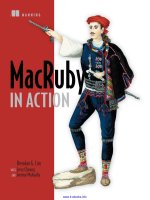Tuscany SCA in Action pot
Bạn đang xem bản rút gọn của tài liệu. Xem và tải ngay bản đầy đủ của tài liệu tại đây (16.56 MB, 474 trang )
MANNING
Simon Laws
Mark Combellack
Raymond Feng
Haleh Mahbod
Simon Nash
www.it-ebooks.info
Tuscany SCA in Action
www.it-ebooks.info
www.it-ebooks.info
Tuscany SCA
in Action
SIMON LAWS
MARK COMBELLACK
RAYMOND FENG
HALEH MAHBOD
SIMON NASH
MANNING
Greenwich
(74° w. long.)
www.it-ebooks.info
For online information and ordering of this and other Manning books, please visit
www.manning.com. The publisher offers discounts on this book when ordered in quantity.
For more information, please contact
Special Sales Department
Manning Publications Co.
180 Broad Street
Suite 1323
Stamford, CT 06901
Email:
©2011 by Manning Publications Co. All rights reserved.
No part of this publication may be reproduced, stored in a retrieval system, or transmitted, in
any form or by means electronic, mechanical, photocopying, or otherwise, without prior written
permission of the publisher.
Many of the designations used by manufacturers and sellers to distinguish their products are
claimed as trademarks. Where those designations appear in the book, and Manning
Publications was aware of a trademark claim, the designations have been printed in initial caps
or all caps.
Recognizing the importance of preserving what has been written, it is Manning’s policy to have
the books we publish printed on acid-free paper, and we exert our best efforts to that end.
Recognizing also our responsibility to conserve the resources of our planet, Manning books are
printed on paper that is at least 15 percent recycled and processed without elemental chlorine.
Manning Publications Co. Development editor: Jeff Bleiel
180 Broad Street Copyeditor: Linda Recktenwald
Suite 1323 Typesetter: Marija Tudor
Stamford, CT 06901 Cover designer: Marija Tudor
ISBN: 9781933988894
Printed in the United States of America
12345678910 –MAL–17161514131211
www.it-ebooks.info
v
brief contents
PART 1 UNDERSTANDING TUSCANY AND SCA. 1
1
■
Introducing Tuscany and SCA 3
2
■
Using SCA components 33
3
■
SCA composite applications 71
PART 2 USING TUSCANY . 107
4
■
Service interaction patterns 109
5
■
Implementing components using the Java
language 132
6
■
Implementing components using other
technologies 175
7
■
Connecting components using bindings 197
8
■
Web clients and Web 2.0 232
9
■
Data representation and transformation 257
10
■
Defining and applying policy 284
www.it-ebooks.info
vi
PART 3 DEPLOYING TUSCANY APPLICATIONS 309
11
■
Running and embedding Tuscany 311
12
■
A complete SCA application 329
PART 4 EXPLORING THE TUSCANY RUNTIME 355
13
■
Tuscany runtime architecture 357
14
■
Extending Tuscany 382
BRIEF CONTENTS
Download from Wow! eBook <www.wowebook.com>
www.it-ebooks.info
vii
contents
preface xvii
acknowledgments xix
about this book xxi
about the authors xxv
about the title xxvii
about the cover illustration xxviii
PART 1 UNDERSTANDING TUSCANY AND SCA 1
1
Introducing Tuscany and SCA 3
1.1 The big picture 5
The basics of SCA 5
■
Tuscany’s Java runtime for SCA 8
1.2 Designing a sample composite application 10
The travel-booking application 10
■
SCA components,
services, and references 12
■
A user scenario demonstrating
service interactions 12
1.3 Implementing a composite application 14
A jump-start to building and running your first SCA
component 14
■
Defining more complex components 18
Creating component implementations 21
■
Wiring
Download from Wow! eBook <www.wowebook.com>
www.it-ebooks.info
CONTENTS
viii
components to form a composite application 24
■
Deploying
a composite application using contributions 25
1.4 Working with other SOA technologies 28
API wrapping 29
■
Using SCA implementations 29
Using SCA remote bindings 30
■
Tuscany and an
Enterprise Service Bus 31
1.5 Summary 32
2
Using SCA components 33
2.1 Implementing an SCA component 34
Choosing an implementation type 35
■
Configuring SCA
components using component definitions 36
■
Discovering or
defining the component type 38
2.2 Using components to provide services 39
Defining services 40
■
Interface definition in SCA 41
Configuring services in component definitions 43
■
Local and
remotable interfaces 44
■
Bidirectional interfaces and
callbacks 45
■
Conversational interfaces 45
2.3 Connecting components using references and wires 46
Defining references 47
■
Wiring references to services 48
Wire elements 50
■
Automatic wiring 51
■
Reference
multiplicity 53
■
Wiring with different multiplicities 54
2.4 Configuring components using properties 56
Defining properties 57
■
Configuring values for properties 58
Using complex types for properties 59
2.5 Enabling communication flexibility using bindings 63
Configuring bindings for services and references 63
■
The default
binding 65
■
Domains, bindings, and wiring 66
2.6 Summary 69
3
SCA composite applications 71
3.1 Running a composite application in a single process 72
Preparing the contributions 73
■
Writing the launcher 75
Running the launcher 76
3.2 Understanding the SCA domain 76
The domain as a contribution repository 77
■
The domain
as a naming and visibility boundary 78
■
The domain
Download from Wow! eBook <www.wowebook.com>
www.it-ebooks.info
CONTENTS
ix
as an execution environment 79
■
Using a single execution
node with a local domain 81
■
Distributed execution within
a domain 83
3.3 Running a distributed composite application 85
Creating an SCA domain 86
■
Installing contributions
into the domain 87
■
Deploying composites for
execution 89
■
Assigning composites to execution nodes 91
Creating and starting execution nodes 93
■
Running
the domain manager from a saved configuration 95
3.4 Using SCA composites as application building blocks 96
Different ways of using SCA composites 97
■
Using
composites as component implementations 97
■
Including
composites in other composites 101
■
Composite reuse
in action 103
3.5 Summary 105
PART 2 USING TUSCANY . 107
4
Service interaction patterns 109
4.1 Understanding the range of SCA service interaction
patterns 110
4.2 Remote interaction 112
Configuring remote interaction 113
■
Exploiting remote
interaction 114
4.3 Local interaction 115
Configuring local interaction 116
■
Exploiting local
interaction 116
4.4 Request response interaction 118
Configuring request response interaction 118
■
Exploiting
request response interaction 119
4.5 One-way interaction 119
Configuring one-way interaction 121
■
Exploiting one-way
interaction 121
4.6 Callback interaction 122
Configuring callback interaction 123
■
Exploiting callback
interaction 126
Download from Wow! eBook <www.wowebook.com>
www.it-ebooks.info
CONTENTS
x
4.7 Conversational interaction 127
Configuring conversational interaction 128
■
Exploiting
conversational interaction 129
4.8 Summary 130
5
Implementing components using the Java language 132
5.1 Defining a Java component implementation 133
5.2 Using SCA annotations in Java implementations 135
5.3 Services and references with Java interfaces 137
Identifying local and remote services 137
■
Implicit and explicit
definition of component interfaces 139
■
Interface compatibility
and mapping 140
■
Transforming messages between
interfaces 141
■
Pass-by-reference and pass-by-value 142
5.4 Java component services 142
The @Service annotation 142
■
Alternatives to the @Service
annotation 143
5.5 Java component references 144
The @Reference annotation and reference injection 145
Reference naming 146
■
Reference multiplicity 146
5.6 Java component properties 147
The @Property annotation and property injection 148
Property naming 149
■
Property types 149
■
Property
value multiplicity 150
5.7 Java component instance creation and scope 151
Stateless, composite, and conversational scopes 151
Interacting with component instance creation
and destruction 152
5.8 Making callbacks 153
The credit card security callback scenario 154
■
Creating a
bidirectional interface with the @Callback annotation 155
The service programming model for callbacks 155
■
The client
programming model for callbacks 157
■
Getting the callback
proxy from the request context 158
■
Using callable references
to provide callback flexibility 159
■
Using a callback ID to
identify a specific callback 161
■
Redirecting the callback
to another service 162
5.9 Holding conversations 163
Defining and controlling conversations in Java
implementations 163
■
Starting, using, and stopping
Download from Wow! eBook <www.wowebook.com>
www.it-ebooks.info
CONTENTS
xi
conversations using annotations 164
■
Controlling
conversations using the SCA Java API 166
5.10 Passing SCA service references 167
A service reference–passing scenario 167
■
Retrieving service
references 167
■
Passing a service reference to another
component 168
■
Making a call via a service reference 168
5.11 Handling errors 169
Business exceptions 169
■
SCA runtime exceptions 173
5.12 Summary 174
6
Implementing components using other technologies 175
6.1 Implementing components using Spring 176
Using Spring services and references without SCA tags 177
Using Spring services and references with SCA tags 180
Setting Spring properties 181
■
Using other SCA Java
annotations 182
■
Finding the Spring application
context 182
6.2 Implementing components using BPEL 183
The structure of a BPEL process document 184
■
BPEL in
Tuscany and SCA 186
■
Mapping WS-BPEL partner
links to SCA services 189
■
Mapping WS-BPEL partner
links to SCA references 190
■
Handling errors 191
Limitations of implementation.bpel in Tuscany 1.x 191
6.3 Implementing components using scripts 192
BSF-based script implementations in Tuscany and SCA 192
Defining interfaces for script-based SCA services and
references 194
■
Mapping between SCA services and scripts 194
Mapping between SCA references and scripts 195
Mapping between SCA properties and scripts 195
Handling errors 195
6.4 Summary 196
7
Connecting components using bindings 197
7.1 Introduction to SCA bindings 198
Using SCA bindings on an SCA service 199
■
Using SCA
bindings on an SCA reference 199
7.2 Demonstrating SCA bindings 200
Overview of the currency converter 200
■
Overview of the
Notification service 201
Download from Wow! eBook <www.wowebook.com>
www.it-ebooks.info
CONTENTS
xii
7.3 Connecting component services with binding.sca 203
7.4 Connecting component services with web services 204
Exposing an SCA service as a web service 205
■
Accessing
a web service using the SCA Web Services binding 207
Configuration options for the SCA Web Services binding 209
7.5 Connecting component services with CORBA 211
Exposing an SCA service as a CORBA service 211
Accessing a CORBA service using the SCA CORBA
binding 214
■
Configuration options for the SCA
CORBA binding 216
7.6 Connecting component services with RMI 217
Exposing an SCA service as an RMI service 218
■
Accessing
an RMI service using the SCA RMI binding 219
Configuration options for the SCA RMI binding 221
7.7 Connecting component services with JMS 222
Exposing an SCA service using JMS 222
■
Accessing a JMS
service using the SCA JMS service binding 225
Configuration options for the SCA JMS binding 227
7.8 Connecting to EJBs 228
Exposing an SCA service as an EJB 229
■
Accessing an EJB
using the SCA EJB binding 229
■
Configuration options
for the SCA EJB binding 230
7.9 Summary 231
8
Web clients and Web 2.0 232
8.1 Servlets as SCA component implementations 233
Creating the currency converter user interface using
a servlet 233
8.2 Writing web component implementations using JSPs 238
Exposing the currency converter using a JSP 238
8.3 HTML pages as SCA component implementations 241
Using an HTML page for the TuscanySCATours user
interface 241
8.4 Exposing file system resources 244
Exposing the TuscanySCATours help pages 245
8.5 Exposing component services as Atom and RSS feeds 246
Exposing the TuscanySCATours blog as an Atom feed 247
Extending the TuscanySCATours blog with an RSS feed 250
Download from Wow! eBook <www.wowebook.com>
www.it-ebooks.info
CONTENTS
xiii
8.6 Referencing Atom and RSS feeds 252
Logging the TuscanySCATours blog Atom feed 252
Logging the TuscanySCATours blog RSS feed 254
8.7 Summary 256
9
Data representation and transformation 257
9.1 Data exchange between SCA components 259
Using WSDL to describe the CreditCardPayment interface 260
Using WSDL in an SCA composite 263
9.2 Representing data within component
implementations 265
Passing data to component references using JAXB
objects 266
■
Accepting data in component services
as SDO objects 271
9.3 Describing data contracts within SCA compositions 274
Specifying contracts on the component type 275
■
Specifying
contracts on component services and references 277
■
Providing
contract configuration to bindings 277
9.4 Data transformations 278
Converting the data coming from the browser from JSON to
JAXB 279
■
Converting from JAXB to AXIOM in order to send a
SOAP request 280
■
Converting from AXIOM to SDO 280
9.5 The Tuscany databinding framework 280
9.6 Summary 282
10
Defining and applying policy 284
10.1 An overview of policy within an SCA domain 285
10.2 The policy runtime 287
Policy interceptors 287
■
The interceptor interface 288
10.3 Using intents and policy sets for implementation policy 289
Adding implementation intents to the composite file 290
Choosing a policy set to satisfy the intent 291
10.4 Using intents and policy sets for interaction policy 293
Adding interaction intents to the composite file 294
■
Adding
interaction intents to the component implementation 296
Choosing a policy set to satisfy the intent at the service 298
Choosing a policy set to satisfy the intent at the reference 300
Running the payment example with authentication enabled 301
Download from Wow! eBook <www.wowebook.com>
www.it-ebooks.info
CONTENTS
xiv
10.5 Other features of the SCA Policy Framework 303
Dealing with policy sets directly 304
■
Profile intents 305
Intent qualification 305
■
Default intents 306
10.6 Tuscany intents and policy sets 306
10.7 Summary 308
PART 3 DEPLOYING TUSCANY APPLICATIONS . 309
11
Running and embedding Tuscany 311
11.1 Understanding the Tuscany runtime environment 312
The SCA domain and Tuscany nodes 312
■
Tuscany
node configuration 313
■
Hosting options for a
Tuscany node 314
11.2 Running Tuscany standalone 315
11.3 Running Tuscany using APIs 317
11.4 Running Tuscany with web applications 319
Configuring WEB-INF/web.xml 321
■
Customizing
class loading policy 321
■
Deploying Tuscany-enabled
web applications 322
11.5 Configuring distributed nodes 322
Defining the contents of the domain code repository 323
Specifying the deployed composites 324
■
Defining the
nodes in the execution cloud 324
■
Configuring bindings
for the nodes in the execution cloud 325
11.6 Embedding Tuscany with a managed container 326
11.7 Summary 328
12
A complete SCA application 329
12.1 Getting ready to run the application 330
12.2 Assembling the travel-booking application 332
The application user interface (fullapp-ui) 334
■
Coordinating
the application (fullapp-coordination) 336
■
Partner services
(fullapp-packagedtrip and bespoketrip) 337
■
Currency
conversion (fullapp-currency) 341
■
Constructing trips
(fullapp-shoppingcart) 341
■
Payment processing
(payment and creditcard) 344
Download from Wow! eBook <www.wowebook.com>
www.it-ebooks.info
CONTENTS
xv
12.3 The travel-booking application in a distributed
domain 346
12.4 Hints and tips for building composite applications 349
Prototyping and then filling out 349
■
Application
organization 349
■
Developing contributions in a team 351
Testing contributions in a single VM 351
■
Top-down and
bottom-up development 352
■
Recursive composition 352
SCA and versioning 353
12.5 Summary 353
PART 4 EXPLORING THE TUSCANY RUNTIME . 355
13
Tuscany runtime architecture 357
13.1 An overview of the Tuscany architecture 358
13.2 A structural perspective of the Tuscany architecture 359
Tuscany core functions 360
■
Tuscany runtime extension
points and plug-ins 362
■
Defining extension points
and plug-ins 364
13.3 A behavioral perspective of the Tuscany architecture 367
Starting and stopping the Tuscany runtime 369
■
Loading
SCA applications 370
■
Building SCA composites 373
Augmenting the composite with runtime artifacts 374
Starting and stopping an SCA component 378
■
Invoking
SCA references and services 379
13.4 Summary 381
14
Extending Tuscany 382
14.1 The high-level view of developing a Tuscany
extension 383
14.2 Developing a POJO implementation type 385
Add the implementation.pojo XML schema 385
■
Adding
implementation.pojo XML processing 386
■
Determining the
component type for implementation.pojo 390
■
Controlling
implementation.pojo invocation and lifecycle 392
■
The
end-to-end picture for the POJO implementation type 394
Packaging the POJO implementation type 396
Download from Wow! eBook <www.wowebook.com>
www.it-ebooks.info
xvi
14.3 Developing a new binding type 397
Adding the binding.echo XML schema 398
■
Adding
the binding.echo XML processor 399
■
Controlling
binding.echo invocation and lifecycle 402
■
The
end-to-end picture for the Echo binding type 407
Packaging the echo binding type 409
14.4 Summary 410
appendix A Setting up 411
appendix B What’s next? 418
appendix C OSOA SCA specification license 423
appendix D Travel sample license 425
index 431
CONTENTS
Download from Wow! eBook <www.wowebook.com>
www.it-ebooks.info
xvii
preface
What brought the five of us together to write a book on Apache Tuscany and Service
Component Architecture (SCA)? We all had practical experience of how difficult and
costly integration of applications and technologies can be, and we were excited about
how Tuscany and SCA can help solve these problems. Having been involved with Tus-
cany and the SCA specifications from the early days, we understood the potential of
this new technology and wanted to share it with you.
Although we’d been entertaining the idea of writing a book for a while, the event
that made it possible was the completion of the SCA 1.0 implementation in Tuscany.
With that we had a real implementation of a service-oriented infrastructure that we
could use to explain SCA through examples. As well as implementing the SCA 1.0 spec-
ifications, Tuscany handles integration with many underlying technologies and enables
users to focus on developing business solutions instead of worrying about infrastructure
details. By writing this book we wanted to help our readers take advantage of the power
of SCA and leverage the many technology choices that Tuscany offers.
Of course, we didn’t see a point in repeating what the SCA specifications already
provide. The specifications define SCA but don’t explain how to use it. Rather, we
chose to address how to use SCA with Tuscany by showing working examples and shar-
ing best practices. There are articles available that give a high-level overview of Tus-
cany and SCA, and there’s some detailed technical information on the Tuscany
website, which assumes a good understanding of the technology. What’s been missing
until now is a hands-on introduction and guide that explains the capabilities of
Download from Wow! eBook <www.wowebook.com>
www.it-ebooks.info
PREFACE
xviii
Tuscany and SCA and shows by practical examples why these are useful to application
developers. This book provides that “missing link.”
We hope that by reading this book you come to share our enthusiasm for SCA as a
rich programming model that makes it easy to create flexible service-based applica-
tions, and that you discover how Tuscany’s wide range of technology support can help
you overcome the challenges posed in integrating service-based applications.
Download from Wow! eBook <www.wowebook.com>
www.it-ebooks.info
xix
acknowledgments
Writing any book presents a challenge, and this is particularly true for a geographi-
cally distributed group of technologists. You’re able to hold the finished book now
because of significant help that we received from other people.
First of all, we’d like to thank the Tuscany community for creating and using the
software, getting involved on the Tuscany mailing lists, and motivating us to write this
book in the first place. We hope this book helps to add some detail to the many topics
that we’ve talked about on the mailing lists over the last few years.
The process of writing has been a voyage of discovery for all of us, and the shape
and focus of the book wouldn’t be what it is without the many reviewers who’ve given
their time to read and comment on the manuscript during its development. This
includes Jeff Davis, Mykel Alvis, Ara Ebrahimi, Doug Warren, Alberto Lagna, Jeff
Anderson, Mike Edwards, Kevin Williams, Marco Ughetti, Robert Hanson, and Tray
Scates. We’re also grateful to the MEAP subscribers who’ve given us valuable feedback
via the Manning forum.
The team at Manning has been particularly helpful and understanding. Megan
Yockey originally commissioned the book, and Marjan Bace gave us the confidence to
get started. Most important, Jeff Bleiel has been our constant companion during the
development of the book, nudging us in the right direction and giving us unfaltering
encouragement. We also thank the many other members of the Manning team who
helped us behind the scenes, including production team members Mary Piergies,
Linda Recktenwald, Allison Cichosz, Katie Tennant, and Janet Vail, as well as Doug
Warren, who did a final technical review of the manuscript during production.
Download from Wow! eBook <www.wowebook.com>
www.it-ebooks.info
ACKNOWLEDGMENTS
xx
It goes without saying that this exercise has taken up many weekends and evenings,
and so our final thanks go to our families.
SIMON L To Maddy, thank you for sticking with it. You can have me back now.
MARK I would like to thank my loving and beautiful wife, Amy, for her enduring
patience and support throughout this project. Perhaps I shall spend less time at my
computer now that it’s finished. Thanks to my daughters, Emily (age 3) and Chloe
(age 1), for their understanding that Daddy sometimes needed to write his book
rather than play princesses or read nursery rhymes. Thanks to our family and friends
for their support and for keeping my girls company while I worked on this book.
RAYMOND I greatly thank my wife, Tao, for accepting my endless excuses to spend
hours of weekend time writing the book. Thanks to my sons, Thomas and Jerry; you
can now have more time with me and be proud of your Daddy for publishing a book.
HALEH I thank my dear family—Bahman, Aurash, and Armaan—who always support
and encourage my endless projects.
SIMON N To my wife, Charlotte, thank you for your understanding and patience as I
spent many hours at the computer and on the phone doing “book stuff,” including a
considerable amount of time while we were traveling in New Zealand. To my sons,
David and Adam, and my parents, thank you for your interest and encouragement in
this venture.
Download from Wow! eBook <www.wowebook.com>
www.it-ebooks.info
xxi
about this book
The Apache Tuscany open source project was created to overcome the challenges
associated with creating, deploying, and managing service-based applications—in par-
ticular, applications made of many components, potentially written using different
programming languages, using different data formats, and communicating with vari-
ous communication protocols. Apache Tuscany, or just Tuscany for short, provides the
infrastructure that solves this problem and allows companies to focus on developing
business components rather than worrying about managing and maintaining the
underlying infrastructure.
The Tuscany project encompasses a number of different technologies, but the glue
that binds everything together is provided by the Service Component Architecture
(SCA). Tuscany SCA in Action focuses on SCA and explains how composite applications
can be developed easily using the Apache Tuscany SCA Java runtime, or Tuscany SCA
for short. This book is a tool for learning SCA and Tuscany. It provides detailed practi-
cal examples and is a guide for those wanting to learn how to create real applications.
The source code for the examples in this book is available from the Apache Tuscany
project at or from
the publisher’s website at www.manning.com/TuscanySCAinAction.
How the book is organized
Tuscany SCA in Action is divided into four parts, plus four appendixes. The first part
introduces SCA as a programming model and Apache Tuscany as the platform for
developing applications using SCA. In this part of the book we introduce the Tuscany-
SCATours travel-booking application. The travel-booking application is developed in
Download from Wow! eBook <www.wowebook.com>
www.it-ebooks.info
ABOUT THIS BOOK
xxii
the book as we cover various aspects of Tuscany and SCA. Part 2 looks in more detail at
SCA’s support for developing services and assembling them into composite applica-
tions. It starts by explaining the SCA-supported component interaction patterns. It
continues with a detailed description of the various implementation, binding, data-
binding, and policy technologies that Apache Tuscany supports. Part 3 explores tech-
niques for deploying the travel-booking application locally or into a distributed
environment. Apache Tuscany supports a number of technologies out of the box to
facilitate integration with a variety of existing technologies. In addition, it offers an
extensible architecture that allows users to extend it with new technologies. Part 4
explains the Apache Tuscany architecture and how it can be extended to support new
technologies.
After reading this book you’ll have a thorough understanding of SCA and its bene-
fits for your business. You’ll learn this through practical examples that are available as
runnable applications from the Apache Tuscany website. You’ll also learn how to join
the community of users and developers who work with Apache Tuscany and extend
Apache Tuscany to support new technologies. Let’s look at how each part is divided
into chapters.
Roadmap
Part 1 consists of chapters 1 through 3. Chapter 1 explains what Apache Tuscany is
and highlights its benefits. It also introduces SCA, including a quick jumpstart for cre-
ating an application using SCA and Tuscany. Chapters 2 and 3 demonstrate most of
the features of SCA at a high level using examples. They highlight how SCA can be
used to assemble components into applications when the components may have been
developed with a variety of technologies, using a variety of data formats and communi-
cation protocols.
Part 2 of the book focuses on understanding the detailed features of Apache Tus-
cany. This part consists of chapters 4 through 10. Chapter 4 covers interaction pat-
terns in composite applications. Chapters 5 and 6 provide examples of developing
components and services using Java, BPEL, Spring, and scripting technologies. Chap-
ter 7 describes how components can be assembled and easily reassembled, using SCA
bindings for a variety of technologies including Web Services, RMI, and more. In
chapter 8 we focus on the client side and how Web 2.0 can be used with SCA to pro-
vide a flexible web client.
Chapter 9 explains how SCA services can use different data formats to interact with
one another. It covers Service Data Objects (SDO) and Java Architecture for XML
Binding (JAXB) as examples.
By now we’ve covered how to create and deploy composite applications. In chapter
10 we talk about how to apply quality of service features to these applications using
policies, for example, to handle security configuration.
Now that we’ve developed a flexible application and shown how to deploy it, in
part 3 we look at the choice of host platforms that Tuscany supports. Tuscany can be
Download from Wow! eBook <www.wowebook.com>
www.it-ebooks.info
ABOUT THIS BOOK
xxiii
embedded into a variety of host platforms, for example, Apache Tomcat, Jetty, and
Apache Geronimo. Chapter 11 covers hosting environment choices. Chapter 12 fin-
ishes off part 3 by describing how the pieces discussed in the earlier chapters come
together to complete the travel application.
Part 4 of the book is for developers who’d like to learn to extend Apache Tuscany
to support new technologies. This part consists of chapters 13 and 14. Chapter 13
describes the architecture of the Tuscany SCA Java runtime. Chapter 14 talks about
how Tuscany can be extended to add a new component implementation and a new
binding type. It also discusses how Tuscany seamlessly handles protocol format differ-
ences between components through its databinding framework and how that too can
be extended.
Tuscany SCA in Action has four appendixes. Appendix A helps you set up your envi-
ronment to run the examples in the book. Appendix B shares some thoughts on likely
future directions for the Apache Tuscany project. Appendixes C and D include copies
of the OSOA SCA specification license and ASF2 license, respectively.
Who should read this book
Tuscany SCA in Action is for all enterprise developers who care about creating reusable
services and assembling those services into flexible composite applications (business
applications). The particular focus is on freedom of choice of technology for develop-
ing component implementations, using communication protocols, and handling data
formats. The book guides you through learning SCA and Tuscany using code examples
and concludes with the assembly and deployment of the travel-booking application.
Although a major portion of the book is focused on developing applications using
Tuscany and SCA, part 4 talks about how to extend Tuscany to support new technolo-
gies. This part is particularly relevant for architects and developers who would like to
extend Tuscany to embrace other technologies not currently supported by Tuscany
and to learn about how to get involved with the Tuscany open source project.
The scope of the Tuscany project is quite broad, and so we assume that you’re
familiar with some of the basic techniques and technologies on which the Tuscany
project builds, in particular the following:
■
The Java programming language
■
XML, XML Schema, and the use of XML namespaces
■
Web Services Definition Language (WSDL) and the use of tools for transforma-
tion between WSDL and Java classes
If you need more information on any of these subjects, then the internet is your
friend. Many online resources are available that you can refer to.
Code conventions
The book contains many code examples. These examples will always appear in a
fixed-width code font
. Any class name, method name, or XML fragment within
Download from Wow! eBook <www.wowebook.com>
www.it-ebooks.info
ABOUT THIS BOOK
xxiv
the normal text of the book will appear in
code
font
as well. All runnable code pieces
will appear as listings. Code annotations accompany many of the listings, highlighting
important concepts. In some cases, numbered bullets link to explanations that follow
the listing.
Author Online
Purchase of Tuscany SCA in Action includes free access to a private web forum run by
Manning Publications, where you can make comments about the book, ask technical
questions, and receive help from the authors and from other users. To access the
forum and subscribe to it, point your web browser to www.manning.com/Tuscany
SCAinAction. This page provides information on how to get on the forum once you’re
registered, what kind of help is available, and the rules of conduct in the forum.
Manning’s commitment to our readers is to provide a venue where a meaningful
dialog between individual readers and between readers and the authors can take
place. It isn’t a commitment to any specific amount of participation on the part of the
authors, whose contribution to the book’s forum remains voluntary (and unpaid). We
suggest you try asking the authors some challenging questions, lest their interest stray!
The Author Online forum and the archives of previous discussions will be accessi-
ble from the publisher’s website as long as the book is in print.
Download from Wow! eBook <www.wowebook.com>
www.it-ebooks.info









